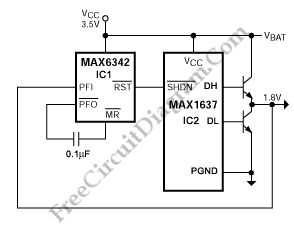Auto Retry for MAX1637 Step-Down Controller

On telecom applications, the MAX1637 is a popular device. This device offer a lot of advantages such as PWM operation, small size, high MOSFET-drive capability, wide VIN and VOUT ranges, and excellent protection against over- and under-voltage faults. An auto-retry controller that attempts to restart the system is often needed in telecom application. Here’s the circuit diagram:

Undervoltage is related to a short circuit:
When a short circuit is present and the controller cannot regulate the supply voltage, the Vout falls. IC2 latches and turns both device off if the voltage remains below 70% of it’s normal value for 6144 clock cycles. You must either turn off the power supply or toggle the active-low SHDN signal to restart IC2.
An internal power-fail comparator and manual-reset circuitry (MR) is included on microprocessor supervisor (IC1). When Vout (1.8V) is above the internal reference voltage (1.25V) will be detected by IC1’s PFI input. The active-low PFO output produces a pulse using the internal 60k pull-up resistor and external 0.1 uF capacitor if Vout falls below 1.25V (due to a short circuit, for instance). The pulse will makes active-low MR low, causing active-low RST to assert and pull active-low SHDN low. Active-low RESET and active-low SHDN go high after a timeout delay of 140ms, re-enabling IC2. The other way to re-enabling IC2 is when the supply voltage is first switched on : the 3.5V rail stabilizes after 140ms will cause active-low RST to go high and activate IC2. [Source: MAXIM Application Note]